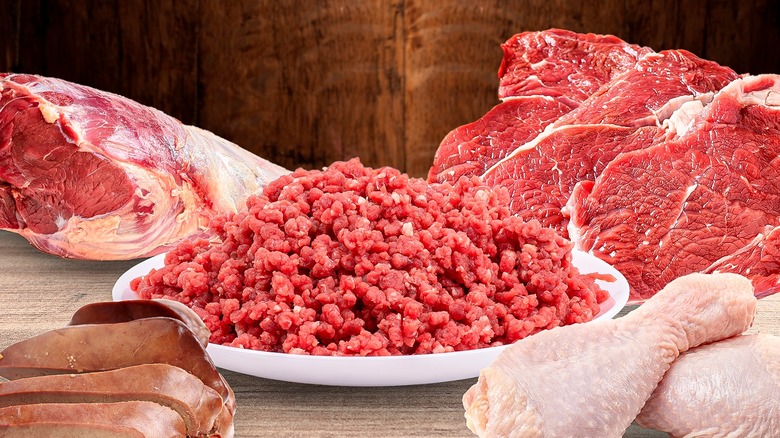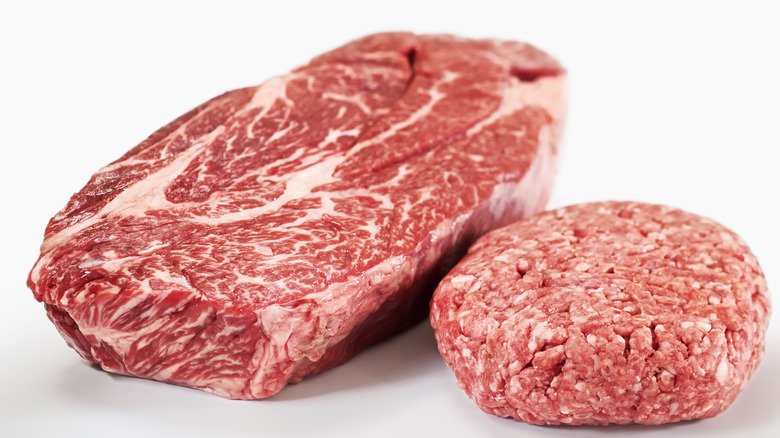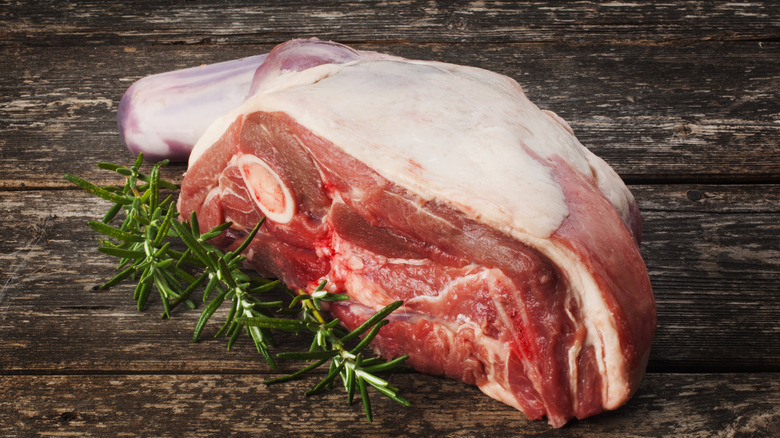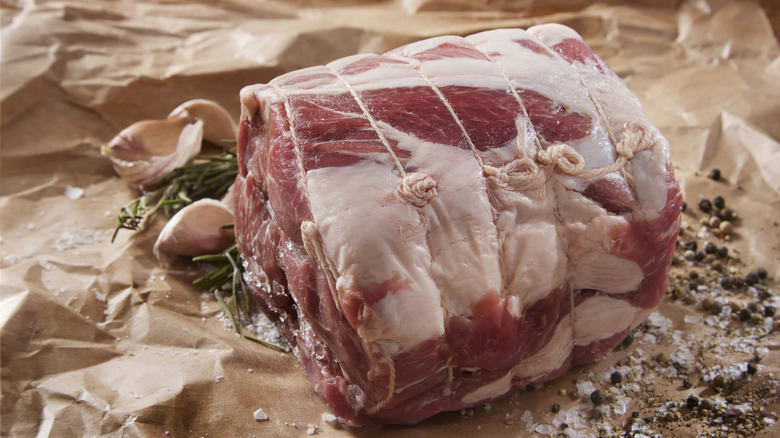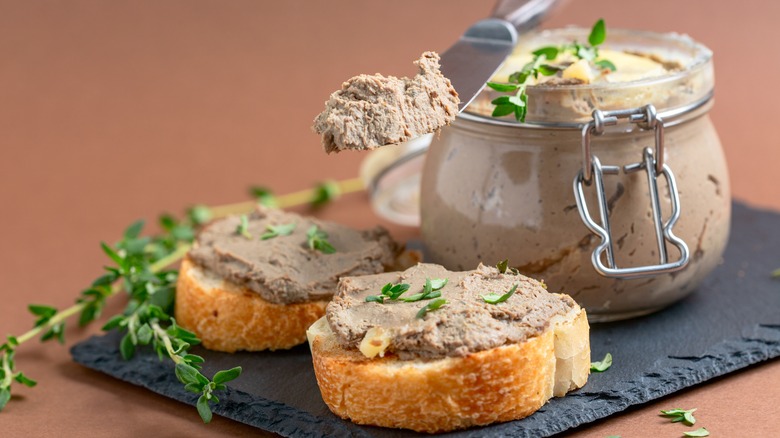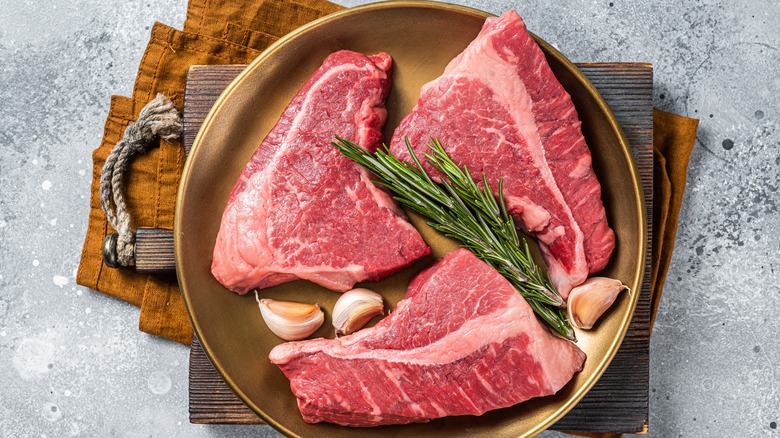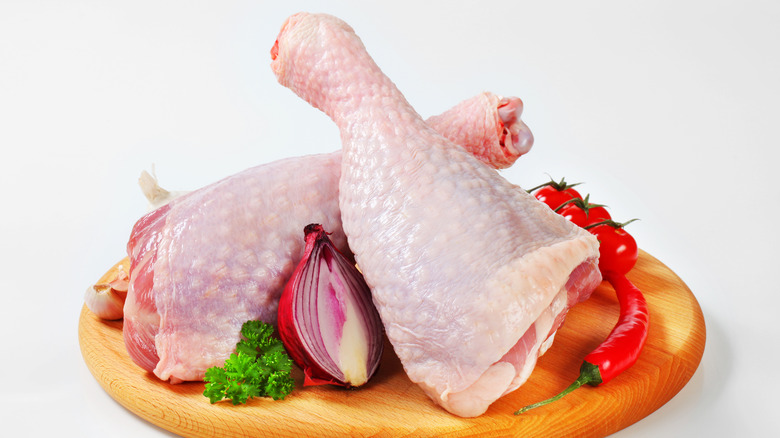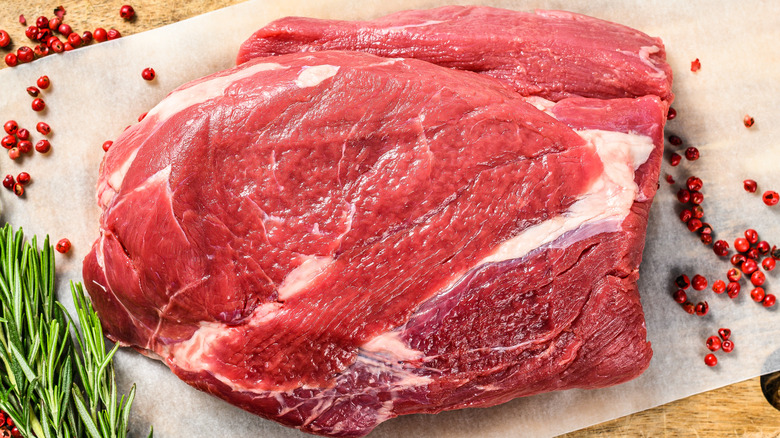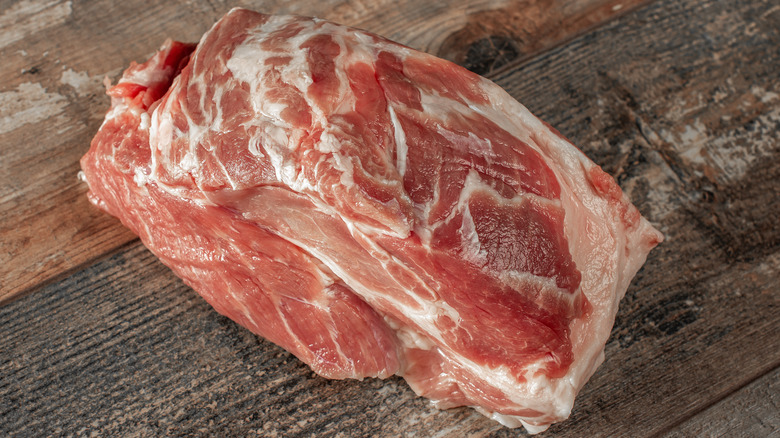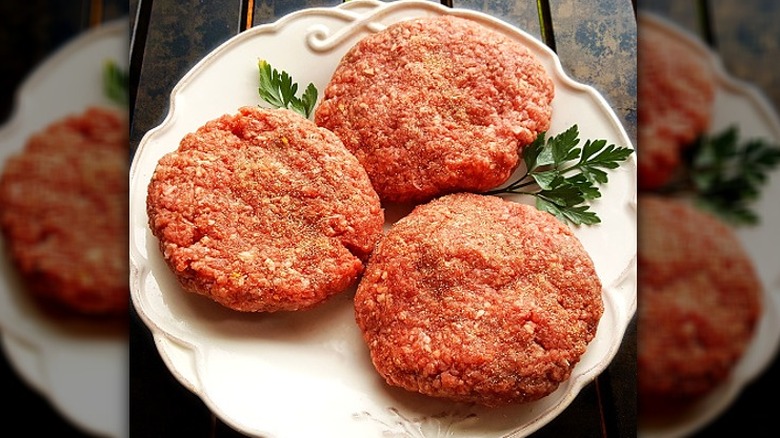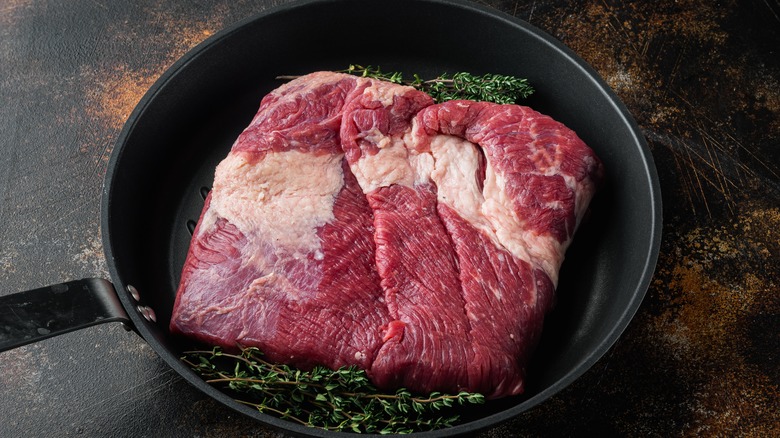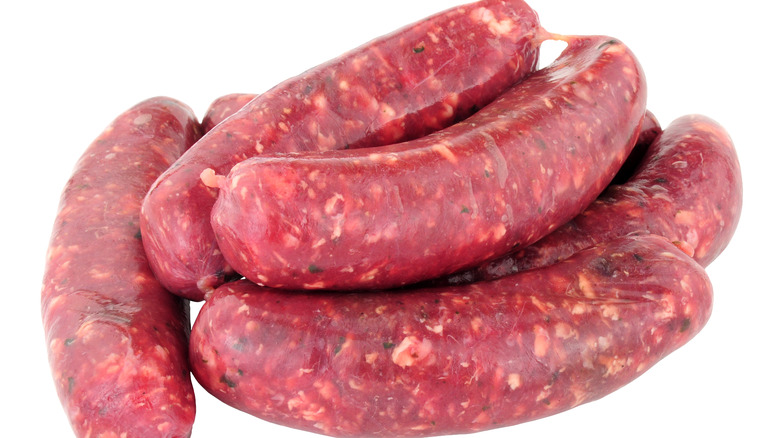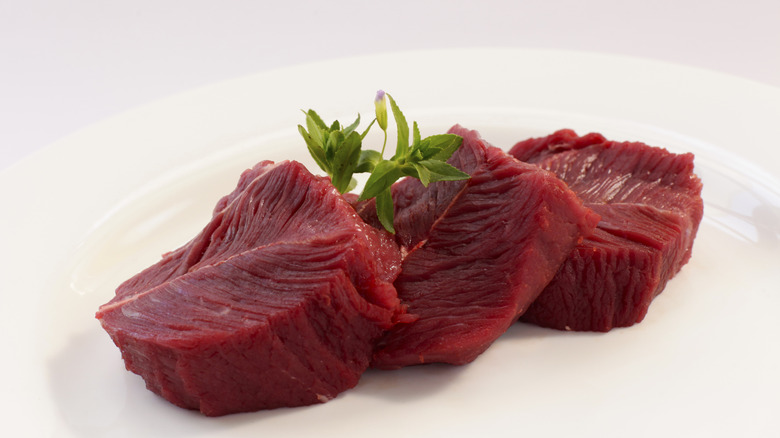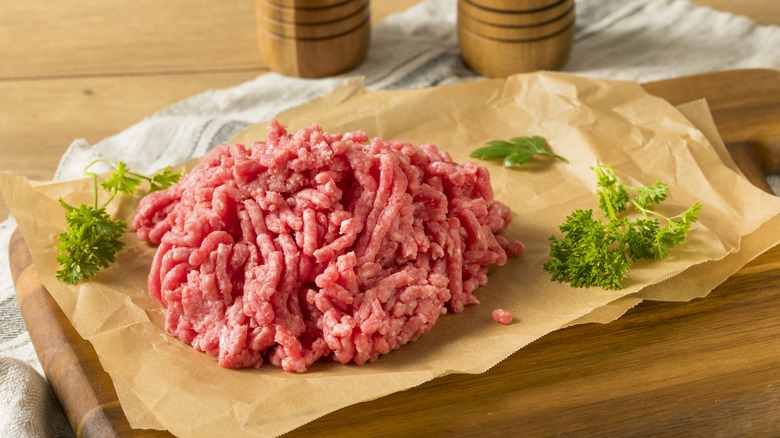13 Cuts Of Meat To Consider For Mincing
Minced is one of the most flexible forms of meat to create and cook with, enabling you to craft dishes that include everything from your grandmother's lasagna to your favorite holiday meat pies and stuffings. Maybe you're familiar with the usual ground beef, but some cuts of meat get bypassed when it comes to mincing. And though we love our go-to ground beef hamburger, we can't forget the savory snap of pork sausages or the smooth texture of liver pâté.
From birds to bovine to game meat, the best cuts for mincing feature a decent fat-to-protein ratio, usually registering at least 20% fat. Sourcing from your local butcher is optimal, but certainly, grinding your own meat can give you control over what cuts of meat you mince and how fatty you want your grind. You can also tailor the grind level, from fine to coarse, to fit your preference. Making your own minced meat and choosing your cuts widens the field of opportunity for orchestrating a host of recipes, flavor profiles, and cuisines.
1. Beef Chuck
Beef chuck is a popular primal cut of meat favored for mincing due to its valued protein-to-fat ratio composition. Butchered from the cow shoulder, beef chuck is a tough cut that turns tender when ground or slow cooked, making it a top option for just about any dish that calls for minced meat.
The deep beef flavor of chuck produces a hearty, choice cut that's loved and used in recipes from Bolognese sauce to homemade sausages. Thanks to the connective tissue that runs throughout, beef chuck provides a meaty chew with a savory richness, complementary to a variety of cuisines around the world. But before you launch into whipping up a masterpiece of ground beef dishes, consider some of the best ways to add flavor when cooking it. Treat the meat right, and your finished dish will showcase its full potential.
Ground chuck is usually easy to find at your local grocer and often packaged in large quantities, from 3-pound roasts to 5-pound packages of ground burgers. So whether you want to concoct a 5-gallon chili for a neighborhood block party or stock your freezer with a week's worth of minced meat, beef chuck is an affordable and tasty way to do both.
2. Lamb Shoulder
Impress your friends at the next barbecue with a burger that goes to the next level. Instead of the tried-and-true ground beef chuck, consider lamb shoulder for your minced meat selection. The shoulder of the lamb is a working muscle and, therefore, a naturally leaner cut of meat. Since leanness equates to tougher meat, lamb shoulder that's been minced is tenderized, resulting in a softer bite and chew. And though it is lean, the shoulder still carries enough fat and collagen to make the juiciest lamb burgers.
If you wish to opt for something other than a burger, ground lamb shoulder is also featured in Indian cuisine, such as biryani, and is one of the ingredients that makes moussaka unique. In fact, Greek cuisine uses ground lamb often since it marries well with other Greek foods, such as Kalamata olives and feta cheese. The sweet, earthy nature of the lamb shoulder pairs with the sharp bite of the feta cheese while adding a balance to the creaminess, and the slightly gamey flavor blends with the rich tang of the Kalamata olive.
3. Pork Shoulder
You can't have some of the best sausages or a mouth-watering pork pie without ground pork shoulder. The #1 choice of meat for making the perfect sausages, pork shoulder consists of leaner meat full of connective tissue that, when broken down inside a casing, renders a juicy, tender, snappy bite of sausage packed with dense flavor. But pork shoulder also shines in the traditional British pork pie— an individual pastry filled with a ground pork mixture that's baked in the oven. It's typically served cold or at room temperature as a snack.
Though other cuts of pork can make equally tasty, minced meat, the pork shoulder holds the right amount of fat and protein while going well with spicy seasonings. But we can't mention pork shoulder without mentioning pork butt. Why? Pork butt, often referred to as Boston butt, is also the shoulder. But what's the difference? Pork shoulder, also known as picnic shoulder, comes from between the shoulder blades and neck, while the butt is considered the rest of the front leg. The butt is a little fattier and more tender than the shoulder, but both make for a great grind that will enhance many minced meat meals.
4. Chicken Liver
When considering the best cuts of meat for mincing, think past the usual grind. Minced meat doesn't have to mean the typical ground crumbles you're most familiar with. Pureeing or blending also creates minced meat, and a super-fine minced chicken liver results in a smooth, spreadable pâté or mousse. Most cuts of meat are turned into minced meat when raw, but pâté and mousse are created by blending the chicken livers after they have been lightly cooked, seasoned, and mixed with other ingredients.
Liver may not suit everyone's taste buds, but chicken liver features a less intense organ flavor than the deeper, richer beef or bison liver. Affordable and frequently available in the supermarket, chicken liver creates a simple yet luxurious, smooth paste that just might rival peanut butter when it comes to spreading it on your favorite bread or crackers. Chicken liver pâté is typically made with garlic, shallot, thyme, salt, pepper, or butter. Chicken liver mousse is often made with cream, butter, shallot, garlic, and herbs.
5. Beef Top Sirloin Butt
Typically thought of as a leaner cut of meat, beef sirloin is a common option for ground burgers due to its inherent toughness but desirable savoriness. If you get to choose which part of the sirloin to grind, top sirloin butt provides plenty of marbling to create tender, juicy minced meat. Situated between the loin and round, top sirloin butt is often cut into subprimal cuts, such as coulotte steak and top sirloin filet. But ground sirloin is frequently featured in your local grocer alongside ground chuck.
When your recipe calls for ground beef, oftentimes, you can cook with whichever beef cut you like best. But sometimes, certain cuts taste better when the minced version has a meatier or fattier texture and is prepared a particular way. For instance, ground chuck is a bit fattier than ground sirloin and makes for better burgers. Whereas ground top sirloin butt is leaner and works better in dishes like tacos or nachos, where sauces tend to play a critical role. The hearty beefiness of the sirloin shines through, while the extra moisture from the accompanying ingredients keeps it from becoming too dry.
6. Turkey Leg
Turkey legs don't have to be only for Thanksgiving dinner anymore. Though serious beef eaters often condemn ground turkey, it has its place among the greats of ground meat. Made up of the thigh and drumstick, a turkey leg has enough fat to create a mince blend that holds taste, texture, and moisture worthy of a stackable burger or tender meatloaf. Consider adding another fat or extra seasoning when cooking with ground turkey.
Fondly referred to as dark meat on poultry, a turkey leg has a higher fat content, as well as larger amounts of myoglobin — the protein that gives the meat a dark color, than the breast, which is considered white meat. Ground turkey that's too lean won't hold much flavor, nor will it build any juice unless you add extra fat to it. The typical ground turkey found at your local supermarket is usually made up of both dark and white meat turkey; this gives it about 15% fat. Of course, you can mix your own turkey grind by blending multiple cuts of meat, such as beef or pork, and add other ingredients to create a custom mince turkey that can be made into any number of ground meat dishes.
7. Beef Outside Round Heel
The outside round heel of the cow benefits from slow cooking and is popular for ground meat due to its deep beefy flavor. Part of the bottom round, which is the hind end of the animal, the heel is relatively inexpensive since it's a working muscle and fairly lean. While it is a leaner cut, grinding the round tenderizes the meat, so the minced version goes well in a number of ground beef dishes. But it's similar to other leaner minced meats that are best paired with sauces or other liquids so as not to become dry.
Outside round heel is not commonly seen in the supermarket separate from the bottom round. You may see merlot steak or braison cut, two subprimal cuts that also come from the round. But if you're not sure, you can always ask the butcher, as they're usually able to fulfill requests. If your recipe specifically calls for the heel and you're unable to source it, you can switch it with ground bottom round, which, depending on where you get it, may have the heel already added in as part of the mix.
8. Pork Butt
Pork butt, which is frequently labeled as Boston butt, is sometimes confused with pork shoulder, which is occasionally labeled as picnic roast because both cuts of meat come from the shoulder of the pig. The difference between the two lies with where on the shoulder the cuts come from. The top portion of the shoulder is where the pork butt is located, and it's the fattier portion of the leg. The lower portion of the shoulder is the cut that is actually referred to as the pork shoulder. This cut is a little leaner since it features more muscle and connective tissue.
Pork butt has a great balance of fat and meat for grinding, but also especially for sausage making. But, of course, ground pork does more than just make great sausages. Ground pork also blends well with ground beef to create classic Swedish meatballs. Don't stop there, though. Ground pork butt also lends fat, heft, and flavor to all kinds of meatloafs, casseroles, and other one-pot meals.
9. Bison Round
If you've stared at packages of ground bison or buffalo in your local supermarket, wondering if it tastes anything like beef, you're not alone. But no, bison is not the same as cattle, nor does it taste quite the same. While both cattle and bison are large ruminants, bison is a pretty lean animal and made up of tough, hard-working muscles. Yet, ground bison makes for a dense, hearty bite of beefy burger that borders on gamey. Overall, ground bison is similar to a richer, leaner cut of beef, like brisket.
The round of the bison, which is cut from the hindquarters, is the most frequently used part for mincing. Sometimes, the round is referred to as hip steak as well. And because it's lean and less tender than domesticated cows, ground bison do well with added fats or moisture to bring out its best. But it's also similar to beef because, in any recipe that calls for ground beef, ground bison may be a welcome swap.
10. Beef Brisket Point
Beef brisket point delivers a tasty upgrade to your typical ground beef burger. Though overall brisket is a lean cut, the point is the fattier end of the entire brisket and provides more moisture for the ground mix. Even though the point is a tough cut, slow-cooking dissolves brisket into tender, juicy, fall-apart bites. What you end up with is one of the most loved cuts of meat.
Cut from the breast of the cow, the brisket is a well-known, sought-after chunk of meat for the smoker or barbecue pit. Commonly seasoned with rubs or treated with brines, grinding the brisket just naturally tenderizes the meat, allowing you to create even more delicious meals with deeper, almost nuttier, minced meat.
So, what's the best way to enjoy ground brisket point? As we mentioned, brisket burgers take your typical hamburger to another level of yum. Top your brisket burger with butter or barbecue sauce, or opt for other ways to add flavor to brisket.
11. Venison Bottom Round
Venison bottom round is frequently made into ground meat since it's a pretty lean cut and is often available in large amounts. But because venison is such a lean game meat, it's typically recommended to add animal fat, like lard or tallow, to the mix so the venison grind doesn't dry out. But venison earns a spot on this list because of its desired flavor profile that's popular in venison sausages.
Located on the hindquarters, the bottom round is situated on the outside of the leg, or hamstring, below the rump and above the shank. A tough, hard-working muscle, venison bottom round requires slow cooking to break down the sinewy muscle fibers and connective tissue. But when ground into minced meat, venison bottom round can be used to make dense, hearty burgers, comforting pot pies, or meatballs with a brandied mushroom gravy.
12. Ostrich
Ostrich is not one of the first carnivorous options to consider when thinking about your next burger and fries. Perhaps not a specific cut of meat for mincing, but ostrich is a great candidate for ground burgers. Classified as a red meat and cultivated from multiple muscle cuts, ground ostrich burger is leaner than most red meat but has a rather robust flavor, similar to beef. And like beef, you can season ground ostrich the way you would a hamburger — with your favorite fixings or condiments.
Even classified as red meat, ostrich doesn't just bring new experiences to dinner; it brings conversation to the table when you serve it in place of ground beef or bison. Ostrich meat can be prepared the same way as beef or lamb. From raw, for dishes like tartare or carpaccio, to medium-rare to well-done, the ground ostrich has the same texture as ground beef or bison, can be shaped into meatballs, patties, and loaves, and pairs with the same seasonings as other red meat.
13. Lamb Flank
We love ground lamb, and though lamb flank is ranked as one of the worst cuts of lamb, it is frequently made into ground meat. The reason it ranks as one of the worst cuts of lamb is because the flank is tough and lean, but grinding it into a mince helps break down the sinewy muscle. Because of the flank's low fat-to-protein ratio, ground lamb flank does best in dishes where other added fats or liquids are present to help add some moisture.
Rich and hearty, and still packing wild lamb flavor, the flank pairs well with other intense ingredients or seasonings, such that you would find in curry or chili. Acidic foods like tomatoes or balsamic vinegar complement the flank by shaving the richness of the lamb with a light, tangy bite. So, while lamb shoulder should be saved for juicy burgers, the flank is preferred for recipes such as herby lamb stuffed tomatoes.
